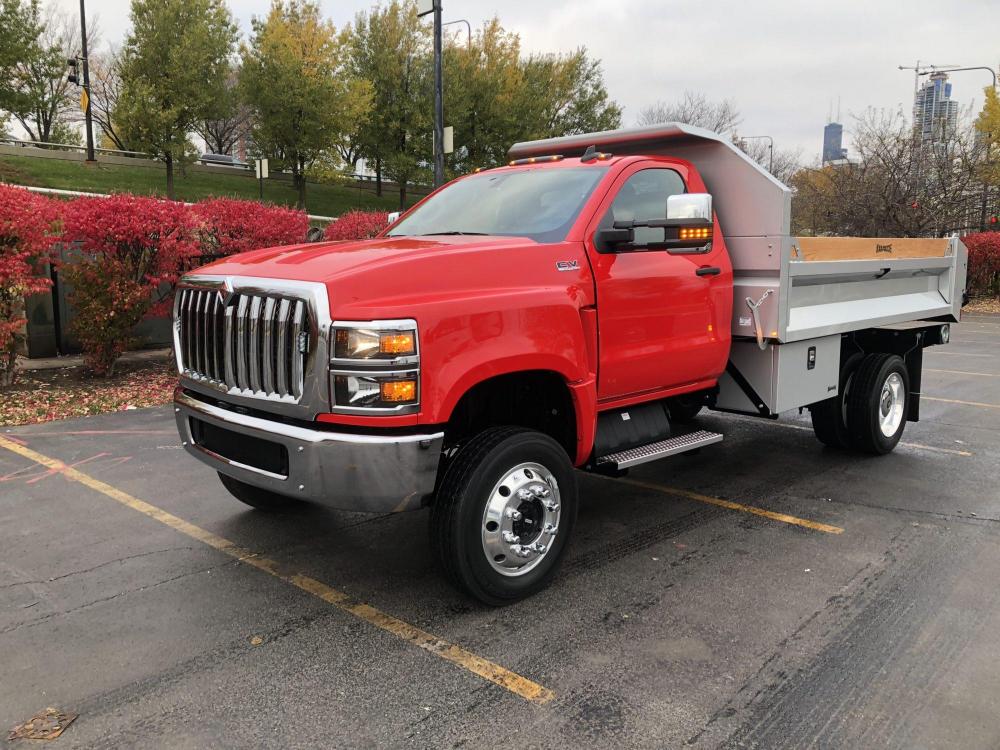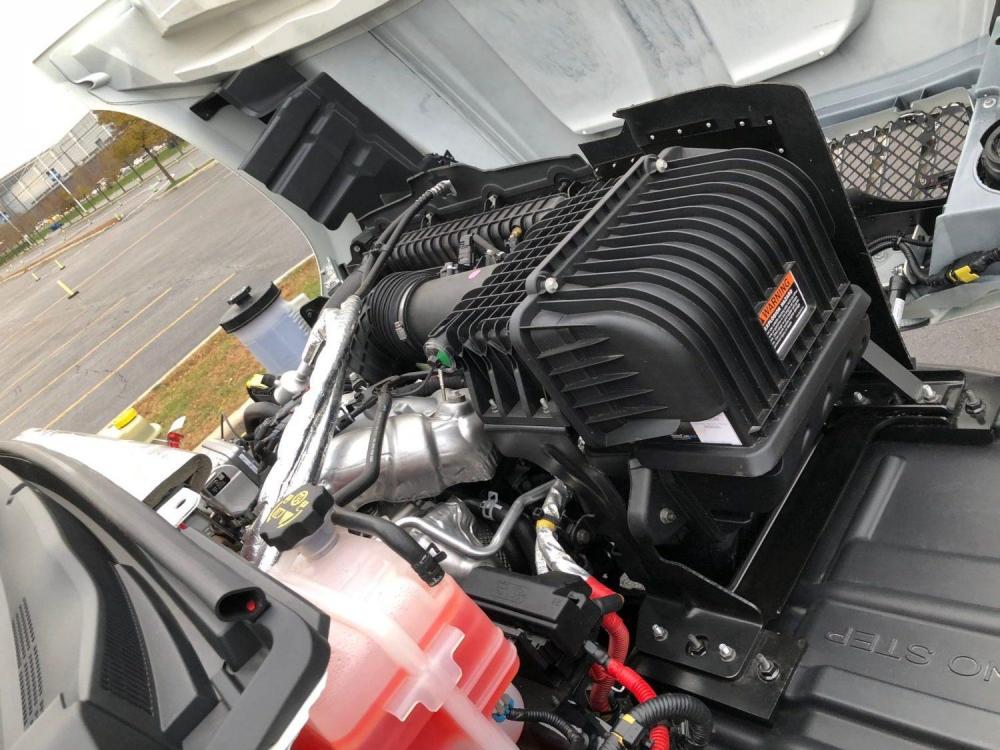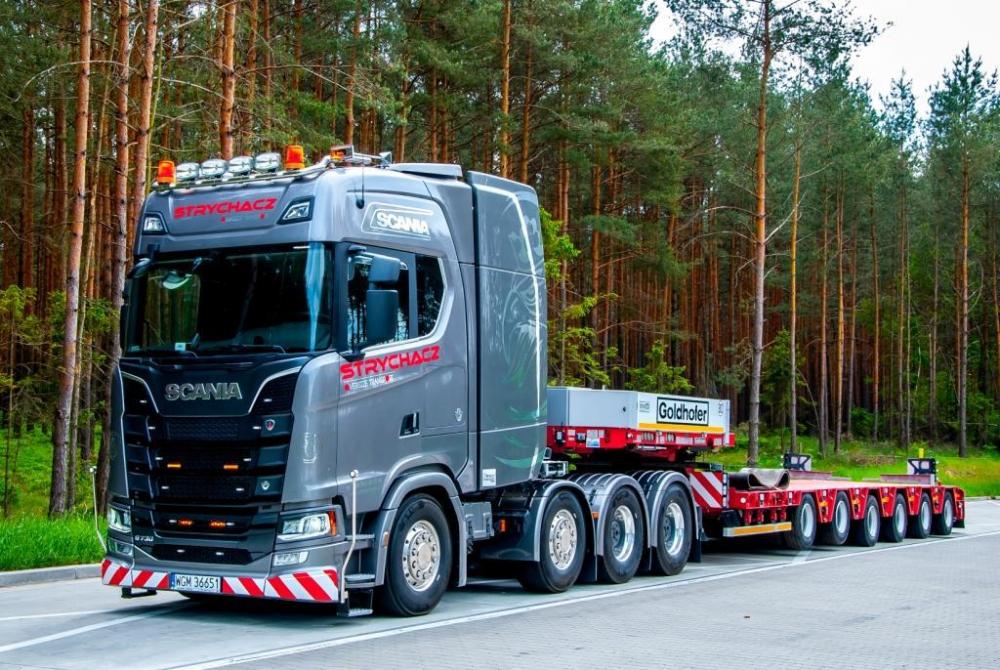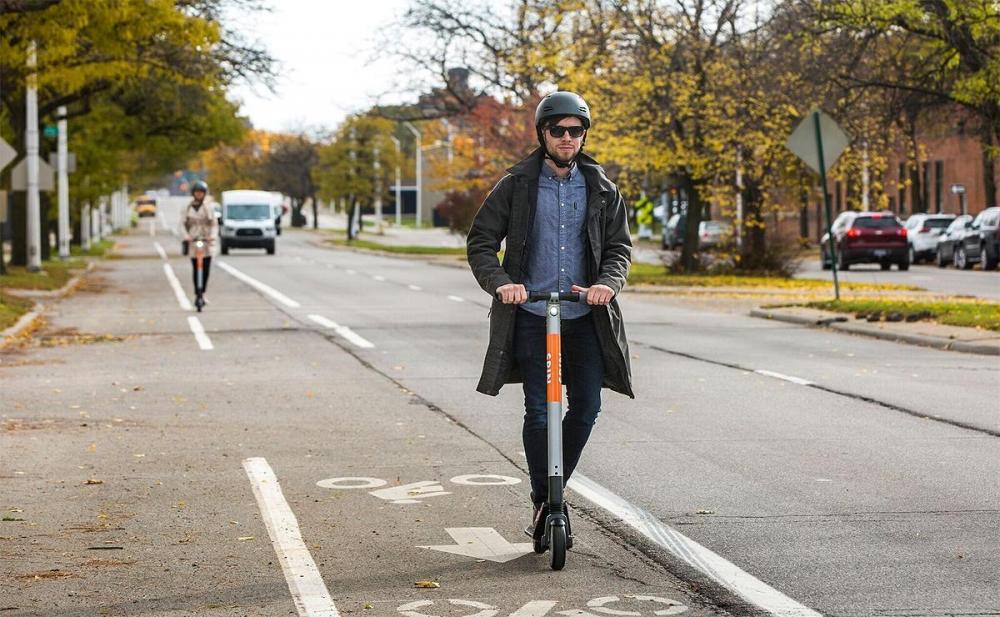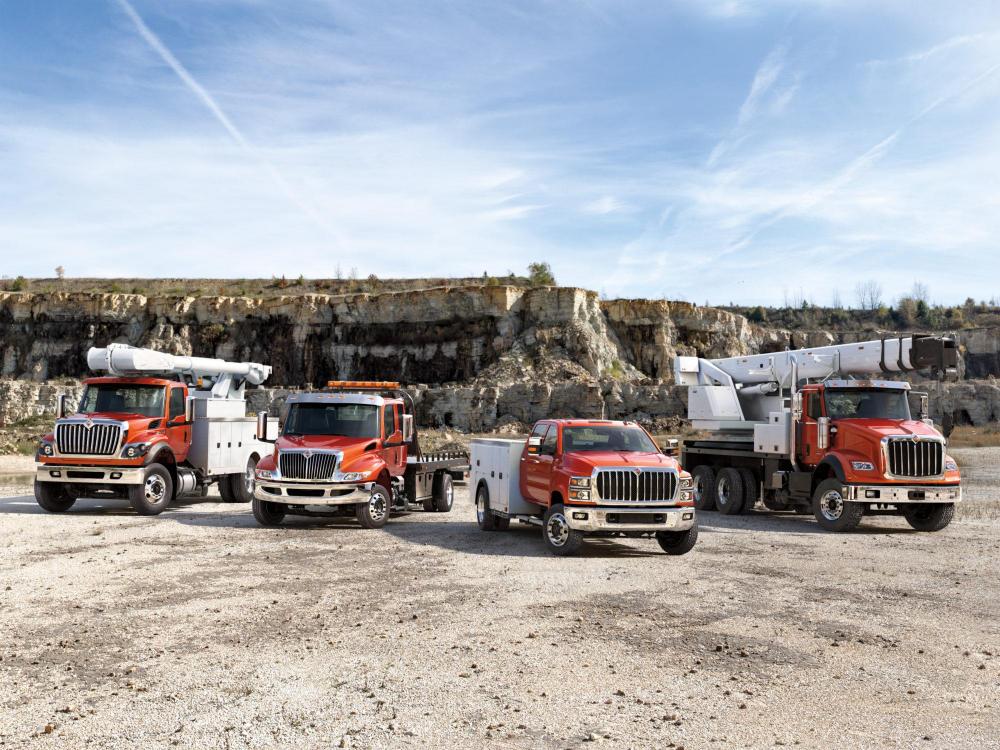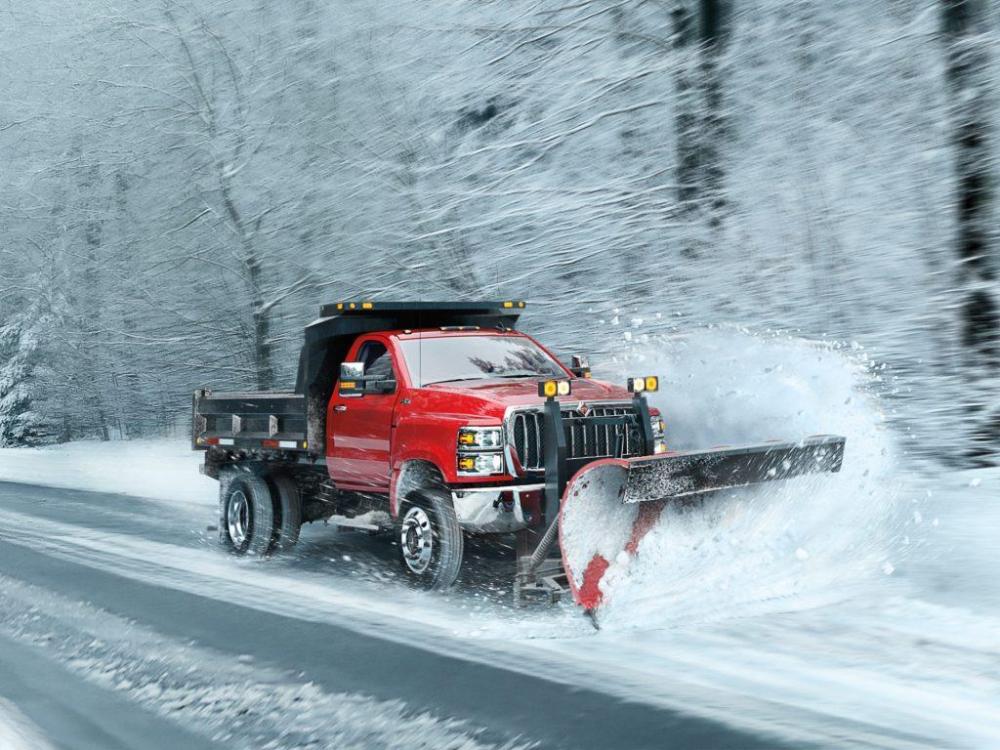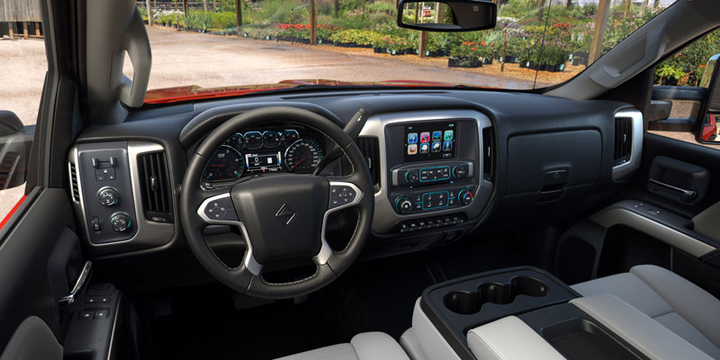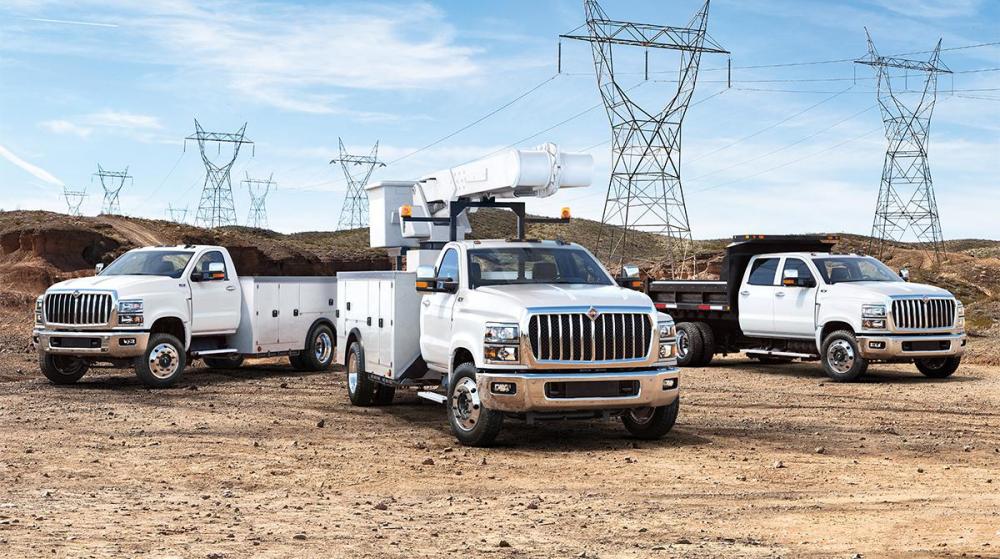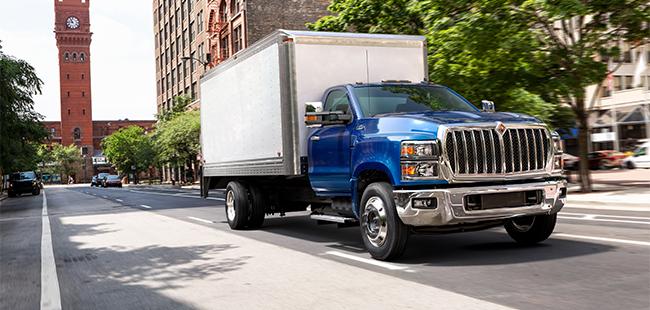
kscarbel2
Moderator-
Posts
18,855 -
Joined
-
Days Won
114
Content Type
Profiles
Forums
Gallery
Events
Blogs
BMT Wiki
Collections
Store
Everything posted by kscarbel2
-
Artificial Intelligence frightens me. .
-
Navistar is out of the gates loudly on the CV Series. Huge potential here. A lot of medium fleets can now standardize on one truck brand down to Class 4. Since the Silverado launch, one hasn't heard a word from Chevrolet (I again say GM commercial should be under the GMC brand). Shall we accept bets on how long it takes Ford and Dodge to launch tilt-hood Class 4/5 models? Speaking of Ford, removing a cab to R&R an engine is absurd (another argument for low-cab-forward COE design).
-
St. Louis Mack Trucks
kscarbel2 replied to autocardc's topic in Antique and Classic Mack Trucks General Discussion
I see "mega dealer" Vanguard Truck Centers bought St. Louis Mack in 2013. Click on locations......https://vanguardtrucks.com/ Alike Caterpillar, the day is coming when there will be 15 or less Mack brand distributor principals nationwide. At distributor meetings, Volvo will save on catering. -
.
-
International intros ‘upfit friendly’ CV Series chassis cab Trailer-Body Builders / November 9, 2018 OEM also looking to attract small businesses, larger fleets that already are customers of its MV, LT Series trucks CHICAGO IL. International Truck recently unveiled its CV Series of trucks, calling itself “the only” OEM to offer Class 4-5 trucks that are designed, distributed and supported by a manufacturer specializing in commercial vehicles. The new truck suits various body types, which International, a unit of Navistar Inc, is targeting for small businesses, growing fleets and current customers of the company’s larger equipment. “To date, there’s only been two competitors in this market for the past several years: Ford and Ram. With Ford dominating this segment for quite some time,” said Michael Cancelliere, Navistar’s president of truck and parts. “We’ve designed, built and tested the CV Series to deliver the commercial-grade power, reliability and practicality that growing businesses require, along with the comfort, safety features and easy drivability that drivers appreciate. And we are backing it up with the expertise of the International dealer network, the only network in this category 100% dedicated to commercial vehicles.” The CV Series’ focus on growing businesses is reflected in the vehicle’s commercial-grade features, which include a gear-driven transfer case, a high-strength, low-alloy steel frame rail and a painted chassis for enhanced longevity and corrosion resistance. The OEM also is looking to attract larger fleets that already are customers of International’s MV Series medium-duty trucks and the heavy-duty LT Series. “They want to have a one-stop shop,” said David Majors, Navistar’s vice president of product development. “They already have a relationship with the dealer in their area. So we think there is a huge opportunity there. Majors said those customers of International’s larger trucks have already shown interest in the CV Series. “When we were developing the vehicle we actually brought in people like Miller, Jerr-Dan (and) Altec to help us when we were defining the vehicle requirements,” Majors said. Earlier this year, Chevrolet also re-entered the medium-duty market with Class 4-6 editions of its Silverado series. Those trucks were developed in conjunction with Navistar thanks to a partnership with GM. International had discontinued its last Classes 4-5 TerraStar model in 2015. “We had a couple opportunities between the two of us,” Majors said of the business arrangement between Navistar and GM. “They had a cab and an engine that would work in the segment. We had some open capacity in our Springfield, OH, plant. So putting that together and looking at the market, we really thought that between the two of us, we could actually make a difference in the market.” That business arrangement is shown off in the automotive-like interior. Multiple infotainment options are available, including an 8-inch color touchscreen with navigation and, for the first time in an International truck, Apple CarPlay and Android Auto. International says it offers the segment’s only optional air ride suspension with an engine-mounted compressor, which can be used to adjust the height and provide a smooth ride for cargo protection and crew comfort. “What we brought to the party from the Navistar side is really the commercial vehicle,” Majors said, noting that things such as the steps are commercial-grade, stamped metal—compared to the plastic steps typically seen on other trucks in this segment. “You get a muddy boot on that step you’re going to be fine,” Majors said, pointing to a CV Series truck. “You get it one of their trucks, you’re going to slide around a bit. So those are the little things we do because we’ve been in the business for so long.” For faster, more convenient service, the CV Series includes a commercial-style forward-tilting hood, which provides easy access to the engine and to routine maintenance points. Under that hood is International’s diesel 6.6-liter, 350-horsepower engine with 700 lb-ft of torque. Equipped with that engine and two Allison transmission options, the CV is capable of handling up to a maximum GCWR of 37,500 lbs. “The CV Series has been compared to a field office with perks,” Cancelliere said. “Our philosophy is that driver comfort is critical to get the job done smoothly and efficiently, and the CV Series brings that philosophy to life.” The truck was tested in extreme environments, including 40 degrees below zero weather in Fairbanks AK, and 115 degrees in Apache AZ, as well as high-altitude testing at 12,000 feet in Loveland Pass CO. “The CV Series features a long list of heavy-duty details that would only be found on a truck designed by commercial truck engineers,” Majors said during the unveiling of the truck in front of hundreds of customers and dealers. “Our engineers had one mission: to create the toughest, most capable, most upfit-friendly Class 4 and 5 truck to be found at any work site.” The CV Series has the ability to accommodate a wide range of specialized body types. Straight frame rails with no rivets on the top flange provide a clean area from cab to axle, making it easy to mount bodies for virtually any commercial-grade application. Like other International trucks, the CV Series is outfitted with HuckBolt chassis fasteners that provide consistently superior clamping force without re-torquing and won’t come loose even in extreme environments. Accommodating the configuration options required by different bodies, the CV Series offers a dual battery box mounted under the cab. The CV Series also includes multiple fuel tank options, optional exhaust outlets to suit the vocation and body and multiple wheelbase options that can suit almost any application. CV Series customers also have access to the same Truck Specialty Center expertise as all International customers. At these centers, which are fully owned and operated by International Truck, experts provide quick, efficient and cost-effective custom engineering solutions. “The CV Series is the only truck in the segment that can take advantage of this level of customization,” Cancelliere said. “No one has more experience at body integration than International Truck.” The International dealer network’s more than 700 service locations feature more than 7,600 ASE-certified commercial diesel-trained technicians in the US and more than 1,900 in Canada—a critical advantage over automotive-based service networks. “Our network is committed to providing the expertise needed to keep your business moving,” Cancelliere said. “No matter the location, if a customer needs service, help is likely to be nearby.”
-
Caterpillar’s Smart Phone Combines Ruggedness and Features
kscarbel2 replied to kscarbel2's topic in Odds and Ends
-
International launches CV Series James Menzies, Truck News / November 8, 2018 CHICAGO, Ill. – International is back in the Class 4/5 segment, with the new CV Series it co-designed with GM. The company unveiled the new model during an event attended by about 500 customers, dealers and media here Nov. 7. It believes customers will benefit from International’s expansive, commercial vehicle-focused dealer network. Moving from start-up to scale-up was the theme behind the launch. “When a start-up business moves to the scale-up stage, the International CV Series provides a truck that will take their business to the next level,” said Michael Cancelliere, Navistar’s president, truck and parts. “We’ve designed, built and tested the CV Series to deliver the commercial-grade power, reliability and practicality that growing businesses require, along with the comfort, safety features and easy drivability that drivers appreciate. And we are backing it up with the expertise of the International dealer network, the only network in this category 100% dedicated to commercial vehicles.” The Class 4/5 segment represents a market of about 40,000 units per year. “These customers operate trucks in unique industries and vocations – everything from towing to landscape, construction to repair services,” Cancelliere said. “To these companies, the truck is an integral part of how they service their customers.” Ford has dominated the segment, but Cancelliere said customers were looking for a new choice. “Customers told us they were ready for a different solution, for a new alternative. They no longer want to do business with automotive dealers that dabble in trucks,” he said. “These customers need a brand that focuses on uptime with service capabilities and dealership hours that meet their needs. They want more than a truck, they want a truck commercial partner to help take their business from start-up to scale-up.” David Majors, vice-president of product development, said the truck was built to handle tough commercial applications. The chassis features 50,000 psi frame rails, and the entire chassis is factory-painted for corrosion resistance. A gear-driven transfer case provides better strength than a chain-driven design, he said. The truck features an air-ride suspension and is powered by a 6.6-liter engine that puts out 350 hp and 740 lb.-ft. of torque. Two Allison transmissions are available. The forward-tilting hood allows easy access to the engine compartment. Majors said body integration will be seamless. “No one has more experience with body integration than International Trucks,” he said. The cab is huck-bolted, with bolts that won’t come loose in extreme conditions. The interior features an automotive design, featuring the GM cab and interior. The truck can be ordered with Apple Car Play and a back-up camera. Regular cab and crew cab configurations are available, in 4×2 and 4×4 drive setups. Customers can choose between three fuel tank options ranging from 25 to 65 gallons. Gross combination weight ratings (GCWR) run to 37,500 lbs. “The CV Series features a long list of heavy-duty details that would only be found on a truck designed by commercial truck engineers,” said Majors. “Our engineers had one mission: to create the toughest, most capable, most upfit-friendly Class 4 and 5 truck to be found at any work site.” On the track Initial test drives were offered to media on two tracks set up in the Soldier Field parking lot. Trucks I drove include a CV515 with set-forward axle in a 4×2 configuration. It was decked out with the Diamond interior and had an Allison 2700 RDS automatic transmission mated to the International 6.6 engine with 350 hp and 700 lb.-ft. The other one I spent some time behind the wheel of was also a CV515 with similar spec’s, but in a 4x4 configuration. It was fitted with an empty dump body but had the same powertrain spec’s. The trucks handled well, with responsive steering and good visibility. The turning radius was tight and acceleration was impressive. The cab was also quiet, and the interior was comfortable and clearly automotive-inspired. The truck will be comfortable to operate for those who expect an automotive driving experience, while the truck is versatile and durable enough to handle a wide range of applications. The real advantage in this segment, however, will be International’s ability to offer true commercial vehicle support and expertise to customers. .
-
VW Considers Investing in Ford-Backed Autonomous Unit Argo Christoph Rauwald & Keith Naughton, Bloomberg / November 9, 2018 Volkswagen and Ford are nearing a framework agreement to join forces on electric and self-driving vehicles, capital-intensive areas that are reshaping the auto industry and straining carmakers’ finances across the globe. As part of the pact, VW may invest in Ford’s self-driving partner Argo AI. VW also is poised to share electric-vehicle technology, with Ford piggybacking onto the tens of billions of dollars that the German giant has committed to battery-powered autos. The possible investment in Argo is significant, as it could accelerate VW and Ford’s self-driving efforts -- a costly but crucially important element of the auto industry’s future. Both carmakers have been dogged by the perception they’re lagging behind in developing the technology, and cooperation would allow them to share costs and potentially catch up faster. Ford shares rallied on the news, jumping as much as 3.6 percent to $9.80 as of 10 a.m. Friday in New York. Talks between VW and Ford have been constructive since the companies publicized them five months ago, and might firm up by the end of this year or early 2019. The two have said they don’t plan a cross-shareholding arrangement like global partners Nissan Motor Co. and Renault SA. VW refused to comment. Jennifer Flake, a Ford spokeswoman, said the company is talking with VW about potential collaboration across multiple areas and that it’s premature to share additional details now. Broad Discussions VW and Ford said in June that they were considering a strategic alliance focused on a range of commercial vehicles. Bloomberg News reported last month that the discussions had broadened to include potential collaborations on autonomous driving and to develop and build vehicles for one another. “We’re having a very broad set of discussions about how we can help each other around the world,” Bob Shanks, Ford’s chief financial officer, said in an interview last month. “Collaboration isn’t being limited in any way whatsoever.” Self-driving cars are expected to upend the transportation industry and become a business worth $7 trillion by mid-century, according to a report last year by Intel Corp. and Strategy Analytics. Automakers who get it right will be on track to more than double the industry’s meager profit margins and build a more prosperous future. But those who fail may not have a future at all. Open to Investment Together with its self-driving partner Argo AI, Ford has said it’s open to outside investment in its autonomous efforts by a second automaker. The talks to bring on VW are progressing well and have the potential to create a global competitor in the self-driving race, one person familiar with the discussions said. Having two major automaker customers would put Argo on similar footing with Cruise Automation, General Motor Co.’s autonomous unit that last month took on a $2.75 billion investment from Honda Motor Co. Ford has been struggling to reverse losses in markets including Europe and South America. It’s also in talks with Mahindra & Mahindra Ltd. to broaden an alliance that began to develop models for India and other emerging markets, including sport utility vehicles and electric cars. VW Chief Executive Officer Herbert Diess confirmed in a recent interview that talks with Ford could involve licensing the company’s new electric-car technology, dubbed MEB. VW plans to roll out the first fully-electric vehicles underpinned by this technology in 2020, starting with the I.D. Neo hatchback in Europe. The deliberations also include VW building a compact panel van about the size of its Caddy model for Ford, while the U.S. manufacturer could produce a successor to VW’s T6 van at its low-cost factory in Turkey to improve returns. In South America, the companies could bundle production of VW’s Amarok and Ford’s Ranger pickups at the German company’s site in Pacheco, Argentina, in a move to share cost. Urban Deliveries Joining forces would allow VW and Ford to gain critical scale in a commercial-vehicle market that’s been boosted by growth in deliveries to online shoppers. At the same time, the segment faces tightening emission rules across the globe: Some major cities are considering allowing only electric vehicles into downtown areas. Combined annual sales of roughly 1.1 million light commercial vehicles would put Ford and VW on par with other alliances like the tie-up between Daimler, Renault and Nissan. For VW’s light commercial-vehicle unit based in Hanover, the Ford cooperation could be key to its future strategy. The division has been struggling to expand outside Europe and South America, partly due to high manufacturing costs for some vehicles in Germany. With the Traton AG heavy-truck unit being separated to prepare a for possible share sale, the light commercial-vehicle operations risk being folded into the much-larger VW cars division if the Ford cooperation doesn’t generate the anticipated benefits in coming years.
-
For Ford, echos of 2005 as debt, outlook weigh on investors Molly Smith, Bloomberg / November 9, 2018 Ford Motor Co. could be close to getting junked again. That's what the bond market is saying. The company's debt is trading like it's speculative grade, as investors worry about how higher steel tariffs and slowing sales will weigh on its profits. Ford is rated one step above junk by Moody's Investors Service and two steps by S&P Global Ratings. Any downgrade could be painful for bond investors, and for the company. The automaker has more than $150 billion of short- and long-term debt globally, and is one of the 15 biggest corporate bond issuers in the U.S. outside of the financial sector. In 2005, Ford was cut to junk along with General Motors Co. Bob Shanks, Ford's CFO, said on an earnings call last month that the company is committed to maintaining its investment-grade ratings, and doesn't intend to lose that status again. The company is "moving with a sense of urgency and taking proactive steps to redesign and restructure the business," and over time 'the market will recognize our progress," Ford spokesman Brad Carroll said. But debt investors are skeptical. The extra yield that money managers get for holding Ford's 4.346 percent bonds due 2026 rather than similar Treasuries jumped to levels typical of high-yield companies. The cost of protecting Ford's debt against default using credit derivatives rose in October to the highest levels since 2012 before settling down again. Moody's downgraded the company in August to one level above junk, and said further cuts are possible in the medium term. "There's a better chance than not it ends up in high yield," said Henry Peabody, a portfolio manager at Eaton Vance Corp. in Boston. "It's a combination of a fairly weak strategic position, less than ideal strategic decisions over last handful of years, a smattering of overconfidence and where we're at in the credit cycle." Ford is fighting a "multiple-front war," Peabody said, citing the company's slowing sales growth in China and higher costs in the U.S. from global trade disputes. Ford fared better during the financial crisis than GM and the Chrysler Group, now part of Fiat Chrysler Automobiles NV, by avoiding bankruptcy and the government-backed bailouts that its competitors received. But losing its investment-grade status forced Ford to finance itself on a secured basis, essentially putting everything from its inventory to the rights to its oval blue logo in hock. When Ford reclaimed its investment-grade ratings in 2012, after it cut debt and profits jumped, Chairman Bill Ford announced the upgrade to employees on the public-address system normally used for fire drills at Ford's Dearborn, Mich., headquarters. "When we pledged the blue oval it was enormously emotional for me personally and for my family, because we weren't just pledging an asset, we were pledging our heritage," Ford said in May 2012. "To get that back feels wonderful and this is one of the best days I can remember." New trouble Now the company is facing difficulty again. Ford told investors in July it is launching an up to five year overhaul that could cost it $11 billion, as it focuses on higher margin products such as trucks, crossovers and SUVs and exits segments that include sedans. However, it has provided scant details on the restructuring plan, and has yet to reschedule an investor meeting that was originally set for September. Struggling operations in Asia and Europe prompted Ford to cut its 2018 profit forecast. The company posted about a 50 percent decline in earnings for the second quarter, followed by a nearly 40 percent decline in the third quarter. Its shares last month fell to their lowest level since 2009. Ford's bonds trade at risk premiums similar to those of junk-rated companies in the auto industry, such as Allison Transmission Holdings Inc. and Dana Inc., and have since Moody's cut the company to a step above junk in late August, according to Bloomberg Intelligence research. The bonds have rallied recently, but still trade at risk premiums higher than Fiat Chrysler, which is rated junk, and GM, signaling investors believe Ford is a bigger credit risk. One source of support as the company tries to fix itself is its cash position: Ford had around $35 billion of liquidity as of Sept. 30. That's given comfort to credit raters, who have noted it as a positive. Earnings margins and operational challenges outside the U.S. are top concerns to Moody's, which rates Ford Baa3. S&P and Fitch Ratings both rate the company one step higher at BBB. More cuts? Ford would need to be cut to high yield by two ratings firms before it fell out of the investment-grade index. Many money managers don't see that as likely, even if Moody's decides to cut the company to speculative-grade, said Joel Levington, a former S&P director and now head of credit research for Bloomberg Intelligence. Ford has options for avoiding downgrades, Levington said, including cutting its dividend -- a step the company has insisted it won't take -- or selling less profitable units. "To get to the place where you're talking about two rating agencies going to high-yield, you're saying not only is the company a basket case, but that it isn't doing anything to stave off either of those actions," Levington said. "I wouldn't assign a high probability around that." To some money managers, current trading levels represent an attractive buying opportunity. The company's bonds pay high yields and the credit quality is relatively high, said Matt Brill, senior portfolio manager at Invesco. "Ford generates a lot of cash flow and they have so much more flexibility than they did a decade ago," with regard to costs, he said. But bond analysts caution that the debt is by no means a slam-dunk investment. Carmakers are cyclical businesses, and as the Federal Reserve raises rates, increasing financing costs for consumers, vehicle sales aren't likely to improve much, if at all, from here. "Autos were always the light that everyone's looked to in this post-recession era," said Jody Lurie, a corporate credit analyst at Janney Montgomery Scott. "I don't think investors are looking at them on that momentum story that they once had, or looking at them as the beacon of hope that they once were."
-
Go drive one for yourself. The only negative will be that afterwards, you'll never want to drive anything else.
-
Note the spin-on oil filter on the drive axles. A Scania standard feature. Why don't US market trucks have such a common sense feature? Designed to wear out from new.
-
Seriously, go drive one for yourself. The only negative will be that afterwards, you'll never want to drive anything else.
-
Your buddy is wrong.
-
Trump and Immigration (Illegal Immigrants in the US)
kscarbel2 replied to kscarbel2's topic in Odds and Ends
Trump moves to deny asylum to most migrants who cross border illegally The Wall Street Journal / November 8, 2018 The Trump administration is moving ahead with a plan to limit when and where foreign nationals can apply for asylum at the U.S. border with Mexico. The administration will publish a new rule aimed at pushing asylum seekers to already crowded border crossings and deny the opportunity to apply for asylum to nearly all immigrants caught crossing the border illegally. President Donald Trump is expected to sign a presidential proclamation that blocks illegal border crossers from the asylum process. Administration officials said the president has the authority to limit asylum for some foreigners under the Immigration and Nationality Act. The rule change and expected proclamation — which could be signed as early as Friday and effectively changes U.S. immigration law — is aimed at reducing the volume of immigrants crossing the border illegally to seek asylum in the U.S. It comes as part of a focus by the president on a group of thousands of mostly Central American migrants making their way to the U.S. in multiple caravans traveling through Mexico. -
Scania Group Press Release / November 9, 2018 The first V8-powered Scania S 730 8×4/4 heavy haulage truck has just been delivered to the Polish specialist in heavy and oversized loads, Strychacz. “This Scania S 730 is now the most powerful tractor in my company,” says owner Ireneusz Strychacz. “I chose Scania because it’s simple to operate, provides good driver comfort, low fuel consumption, and is trouble-free.” Strychacz has been operating Scania since 1989 when it purchased its first truck. It now has 16 heavy haulage Scania trucks in the fleet. The company carries out demanding transport assignments throughout Europe with customers in Poland, Germany, the Netherlands, Belgium, Sweden and the Czech Republic. “From the very beginning I’ve had Scania trucks,” says Strychacz. “First, it was standard transport and later heavy-haulage. We transport planes, tanks, propellers, pipes, gantries, construction machines – well, everything we can carry.” .
-
Somali immigrant in Melbourne, Australia. Blows up a ute, stabs 3, killing 1. .
-
VW said to plan Tesla rivals for less than $23,000, may share van production with Ford Jan Schwartz and Edward Taylor, Reuters / November 9, 2018 FRANKFURT -- Volkswagen Group intends to sell electric cars for less than 20,000 euros ($22,836) and protect German jobs by converting three factories to make Tesla rivals, a source familiar with the plans said. Plans for VW's electric car, known as "MEB entry" and with a production volume of 200,000 vehicles, are due to be discussed at a supervisory board meeting on Nov. 16. Another vehicle, the I.D. Aero, will be built in a plant in Emden, Germany,currently making the VW Passat midsize sedan. The automaker, which declined to comment on the plans, is also expected to discuss far-reaching alliances with battery cell manufacturer SK Innovation and rival Ford. The November 16 strategy meeting will discuss VW's transformation plan to shift from being Europe's largest maker of combustion engine vehicles into a mass producer of electric cars. VW's strategy shift comes as cities start to ban diesel engine vehicles, forcing automakers to think of new ways to safeguard 600,000 German industrial jobs, of which 436,000 are at car companies and their suppliers. Ford production An electric van, the ID Buzz, is due to be built at VW's plant in Hanover, where its T6 van is made. To free up production capacity for electric cars in Hanover, VW's T6 transporter vans could be produced at the Ford-Otosan plant in Turkey, if German labor unions, who hold half the seats on VW's board of directors, agree. VW and other automakers are struggling to adapt quickly enough to stringent rules introduced after the company was found to have cheated diesel-emissions tests, with its CEO Herbert Diess warning last month that Germany's auto industry faces extinction. VW and Ford are in "exploratory talks" about an alliance to develop self-driving and electric vehicles and to complement each other's global production and sales footprints, Reuters reported last month. Ford has strong sales and profits in the U.S. thanks to its exposure to the lucrative pickup truck segment, while VW dominates the market for passenger cars in Europe. The companies are considering cooperation deals in the areas of commercial, electric and autonomous vehicles, although a final agreement will unlikely be announced at the November 16 strategy meeting at Volkswagen. The details of a cooperation deal with Ford may take until the end of the year to be finalized, the second source said. VW will mainly focus on debating the merits of converting its factories in Emden, Zwickau and Hanover, which all build combustion-engine cars, to electric ones under the plans being discussed by the board of directors. Jobs threat EU lawmakers have agreed to seek a 35 percent cut in car emissions by 2030 after a U.N. report called for dramatic steps to slow global warming. VW CEO Herbert Diess said to cut average fleet emissions of carbon dioxide in Europe by 30 percent by 2030, VW needs to raise its share of full-electric vehicles to 30 percent of new-car sales. The shift from combustion engines to electric cars would also cost 14,000 jobs at VW by 2020 as it takes less time to build an electric car than a conventional one and because jobs will shift overseas to battery manufacturers. In Europe, there are about 126 plants making combustion engines, employing 112,000 people. The largest such plant in Europe is VW's in Kassel, Germany.
-
Ford buying scooter company Spin Michael Martinez, Automotive News / November 8, 2018 DETROIT -- Ford Motor Co. is buying an electric scooter company called Spin, the automaker said Thursday, in a bid to expand its mobility offerings and reach consumers who need short-distance transportation solutions. Ford said the scooters will roll out in 100 cities over the next 18 months, including a Thursday launch here. "We understand mobility is not just vehicles at this point," Sunny Madra, vice president of Ford's mobility incubator, Ford X, told Automotive News. "This is our play in addressing the micromobility business." News of the acquisition comes a week after crosstown rival General Motors said it would launch a new brand and lineup of electrified bicycles in 2019. Ford also offers bicycles through Ford GoBike, a West Coast bike rental service. Ford did not reveal the purchase price for Spin. Axios, which reported the deal Wednesday afternoon, described it as being "in the range of $40 million," citing a source. Dockless electric scooters have exploded in popularity in cities across the U.S. in recent months. Customers can download an app, locate a scooter, scan a code and ride. Prices are typically $1 to unlock a scooter and 15 cents per minute of usage. Scooter startups, including Lime and Bird, have said customers have taken 10 million rides in less than a year. By comparison, Madra said it took Uber three years to reach 3 million rides. "That showed us there was a significant market," said Madra, who came to the company from Autonomic, a startup that Ford Smart Mobility bought in January. "It became obvious to us we wanted to accelerate in this space." Ford partnered with Purdue University this year to offer electric scooters as part of a research project designed to determine how best to launch them in different communities. Critics of the services argue some companies dump hundreds of scooters in a city without getting permission from local governments. Spin, which launched its scooter service in February, has operations in 13 cities and campuses across the U.S. Madra said the company has made a point to engage with every city before it launches, which was a big reason Ford chose it. "They do not launch without permission; they share usage data with cities; and they work with local officials and university campuses to design educational tools around parking and riding rules," Madra said in a blog post expected to go up Thursday. "This approach aligns well with our values at Ford and with our ambition to be the world's most trusted company." The amount of scooters available in each city will vary; Detroit, for example, limits companies to 400 each. Ford plans to keep the Spin name and doesn't expect to put any of the automaker's branding on the scooters, Madra said. He declined to say whether Ford expects the business to be profitable, saying only that the company thinks "it represents a healthy business for us." .
-
International unveils CV work trucks John G. Smith, Today’s Trucking / November 7, 2018 CHICAGO, Ill. – It seems somewhat appropriate to give a series of work trucks its own CV. Sure, the letters can stand for curriculum vitae – the document most of us refer to as a resume – but International Truck has taken that a step further by stamping the letters onto its new CV Series of Class 4 and 5 vehicles. And these trucks with gross vehicle weight ratings of up to 22,900 lb. are clearly designed for an array of jobs. “We’ve designed, built and tested the CV Series to deliver the commercial-grade power, reliability and practicality that growing businesses require, along with the comfort, safety features and easy drivability that drivers appreciate,” said Michael Cancelliere, Navistar’s president – trucks and parts. “We are backing it up with the expertise of the International dealer network – the only network in this category 100% dedicated to commercial vehicles.” Stressing “commercial grade” attributes during a launch event in Chicago, International referred to features including a gear-driven transfer case with no chains to stretch, a low-alloy steel frame rail with a 50,000 psi yield strength, and a painted chassis to help combat threats like corrosion. Tucked under the three-piece, forward-tilting hood with an integrated safety latch is International’s 6.6-liter engine delivering 350 hp and 700 lb-ft of torque. And depending on which Alisson transmission is selected, the truck can boast a gross combination weight rating of 37,500-lb. The CV comes with 1700, 1750 or 2700 Series six-speed Allison transmission, with a power takeoff (PTO) available for auxiliary equipment. Available vocation codes include the Highway Series (HS), Rugged Duty Series (RDS), Emergency Vehicle Series (EVS), or Motorhome Series (MS). As a 4×2, gross vehicle weight ratings (GVWR) range from 16,000 to 22,900 lb., while 4×4 models deliver 17,500 to 22,500 lb. The 4×2 can come with a 6,000-, 7,000, or 8,000-lb. Dana Spicer front axle, while the 4×4 comes with a 7,500-lb. model. Dana Spicer axles ranging from 10,000 to 15,500 lb. round out things at the rear. Maneuverability comes courtesy of a 50-degree wheel cut, while visibility can be enhanced with an optional rearview camera and heated side mirrors that feature LED turn signals and rear-facing LED lights to shine on cargo and equipment. For those exposed to particularly challenging job sites, the CV features 4×4 capabilities and Meritor’s gear-driven transfer case. A skid plate is also available, while the front end, grille and radiator can be further protected with a four-inch bumper extension. And there’s the option of a Dana Spicer Truetrac torque proportioning limited slip differential. The stopping power comes courtesy of a Hydromax braking system, Bosch Split system with traction control, four-channel antilock braking system (ABS), diesel exhaust brake, and trailer brake controller. It was all tested in environments from -40 to 46 Celsius, and at altitudes up to 12,000 feet. Those who face some of the colder temperatures among them have the option of a 120-volt, 800-watt block heater to get things moving, too. Building bodies For many users, of course, the truck’s true capabilities emerge through upfitting by body builders. Their work is eased with straight frame rails that have no rivets on the top flange, ensuring a clean area stretching from the cab to the axle when mounting bodies. HuckBolt chassis fasteners, also found on other International trucks, deliver their clamping forces without requiring re-torquing. The front frame includes standard holes for a snow plow mounting bracket as well. A dual battery box is mounted under the cab, while an optional third battery is also available for mounting, and there are multiple fuel tank options including a 40-US gallon version mounted after frame and behind the rear axle, a 25-gallon saddle tank, or dual tanks. The diesel exhaust fluid (DEF) tank has been mounted by the passenger door to help ensure the right fluid goes into the right port. Wheelbase options that range from 141 to 243 inches, as well as optional exhaust outlets, are all suited for different tasks. Comfort and interiors Another option comes in the form of the uAir International air ride suspension with an engine-mounted compressor, which can be used to adjust heights and ride alike. That suspension, available only in 4×2 configurations, is rated at 12,000 to 15,500 lb. But this is not the only way driver comfort is enhanced. Inside the cab, options include an array of infotainment systems, including up to an eight-inch color touch screen with navigation and – for the first time in an International truck – Apple CarPlay and Android Auto. (The touch screen in classic trim packages measures seven inches.) Classic trim packages include a 3.5-inch monochromatic display featuring warning messages and vehicle information, while diamond trim designs go bigger with a 4.2-inch color display. Other controls across the dash have been designed to be worked while wearing gloves. Built-in switch packs control various functions, and up to four auxiliary switches are available depending on the trim level. A floor-mounted center console is available with moveable cup holders, cell phone storage, 12-volt charger, a pair of USB ports and hanging file folder, depending on the configuration. And the three-across seating includes a center seat back that can be lowered and used as an armrest and beverage holder, while the seat bottom cushion offers extra storage. Trim packages include a classic in a soft touch vinyl or cloth, or a diamond trim with cloth. In each case the color is a dark ash or black. Diamond features in the crew cab include things like a leather-wrapped steering wheel, 10-way power bucket non-suspension high back driver’s seat with headrest and power lumbar, and non-suspension high back passenger seats with six-way power adjustments and power lumbar. Said Cancelliere: “The CV has been compared to a field office with perks.” Support No matter which vehicle is spec’d, buyers will be able to access Truck Specialty Centers available to other International truck users. “The CV Series is the only truck in the segment that can take advantage of this level of customization,” Cancelliere added. “No one has more experience at body integration than International Truck.” International has more than 700 service locations across North America, with more than 1,900 diesel technicians in Canada alone. And the company says it has more dedicated commercial truck bays than Ford, Chevrolet or Ram. .
-
International Debuts CV Series Class 4/5 Truck Heavy Duty Trucking (HDT) / November 7, 2018 International Trucks unveiled its new CV Series, a Class 4/5 truck that it emphasizes is designed, distributed and supported by a company specializing in commercial vehicles. In its Nov. 7 announcement in Chicago, the company touted the truck’s commercial-grade features, starting with a gear-driven transfer case, a high-strength, low-alloy steel frame rail, and what International says is the industry’s only painted chassis for enhanced longevity and corrosion resistance. For faster, more convenient service, the CV Series includes a commercial-style forward-tilting hood, which provides easy access to the engine and to routine maintenance points. Under that hood is the International 6.6L, 350-hp engine with 700 lb.-ft. of torque. With two Allison transmission options, the CV is capable of handling up to a maximum GCWR of 37,500 pounds. Upfit-friendly The CV Series can accommodate the wide range of specialized body types, from delivery trucks to utility trucks. Straight frame rails with no rivets on the top flange provide a clean area from cab to axle, making it easy to mount bodies for virtually any commercial-grade application. Like other International trucks, the CV Series is outfitted with HuckBolt chassis fasteners, which it says provide consistently superior clamping force without re-torqueing and won’t come loose even in extreme environments. Accommodating the configuration options required by different bodies, the CV Series offers a dual battery box mounted under the cab, as well as multiple fuel tank options, optional exhaust outlets to suit the vocation and body, and multiple wheelbase options. CV Series customers also have access Truck Specialty Centers, owned and operated by International Truck, for custom engineering solutions. Driver comfort The International DriverFirst philosophy, which it announced in 2016 and used as it redesigned its line of heavy-duty trucks, also is at work with the CV. The truck offers automotive-like comfort, featuring premium interior finishes and outstanding driver ergonomics, says the company. Multiple infotainment options are available, including an 8-inch color touch screen with navigation and, for the first time in an International truck, Apple CarPlay and Android Auto. Added comfort is offered by what International says is the segment’s only optional air ride suspension with an engine-mounted compressor, which can be used to adjust height and provide a smooth ride for cargo protection and crew comfort. Spec Highlights • Available in regular and crew cab • GVWR of 16,000-22,900 pounds for the 4x2 version and 17,500-22,500 for the 4x4 • Wheelbase options of 141-243 inches • Available transmission-mounted, right side PTO (requires PTO-equipped transmission) • Brakes: Hydromax with Traction Control and Four Channel ABS • Available International Ride Optimized Suspension (IROS) provides smooth ride and height adjustability (4x2 only) • Transfer Case (4x4) Meritor 2-speed, Gear Drive , 3,000 lb.-ft. capacity with electric shifting controls, with optional skid plate .
-
Transport Topics / November 7, 2018 CHICAGO — International Truck, a unit of Navistar Inc., launched its International CV Series Nov. 7 by underscoring it is “the only” Classes 4-5 truck designed, distributed and supported by a manufacturer specializing in commercial vehicles. The truck, which accommodates a wide range of specialized body types, is aimed at businesses that are expanding, such as landscapers and tow companies, according to the Lisle, Ill.-based company. To provide drivers with automotive-like comfort, the truck features premium interior finishes and driver ergonomics. Multiple infotainment options are available, including an 8-inch color touch screen with navigation and, for the first time in an International truck, Apple CarPlay and Android Auto. “We’ve designed, built and tested the CV Series to deliver the commercial-grade power, reliability and practicality that growing businesses require, along with the comfort, safety features and easy drivability that drivers appreciate,” Michael Cancelliere, Navistar’s president of Truck and Parts, said in a statement. “And we are backing it up with the expertise of the International dealer network, the only network in this category 100% dedicated to commercial vehicles.” By moving into the Classes 4-5 space, International — which already sells Classes 6-8 trucks — is going up, primarily, against Ford Motor Co., which dominates the Class 5 category and also Dodge Ram, a unit of Fiat Chrysler Automobiles N.V. U.S. retail sales of Class 5 trucks though September totaled 59,898 — Ford accounted for 38,241, good for a 64% share, according to WardsAuto.com. Dodge Ram’s sales were second highest in Class 5 at 11,628 for the nine-month period. Isuzu Commercial Truck of America Inc.'s low-cab-forward models notched the lion’s share of Class 4 sales through September — 8,934 out of a total of 14,662, according to Ward’s. Among the commercial-grade features on the CV Series are: a gear-driven transfer case, a high-strength, low-alloy steel frame rail and what International said is the industry’s only painted chassis for enhanced longevity and corrosion resistance. Intended for faster, more convenient service, the CV Series includes a commercial-style forward-tilting hood, which provides easy access to International’s diesel engine — a 6.6-liter, 350-horsepower engine with 700 pound-feet of torque — and to routine maintenance points. Equipped with that engine and two Allison transmission options, the CV is capable of handling a maximum weight of 37,500 pounds. The CV Series also offers a dual battery box mounted under the cab, and multiple fuel tank options, optional exhaust outlets to suit the vocation and body, and multiple wheelbase options. In addition, International’s Application Engineering Team offers access to vocational engineering experts who can help customers design a configuration geared to their application. “The CV Series is the only truck in the segment that can take advantage of this level of customization,” Cancelliere said. “No one has more experience at body integration than International Truck.” The International dealer network’s more than 700 service locations feature more than 7,600 ASE-certified commercial diesel-trained technicians in the United States and more than 1,900 in Canada — “a critical advantage over automotive-based service networks,” the company said in a statement. The CV Series will be the last product rolled out as the company refreshes its entire lineup of trucks. It is the successor to International’s Classes 4-5 TerraStar model, which it discontinued in 2015. .
BigMackTrucks.com
BigMackTrucks.com is a support forum for antique, classic and modern Mack Trucks! The forum is owned and maintained by Watt's Truck Center, Inc. an independent, full service Mack dealer. The forums are not affiliated with Mack Trucks, Inc.
Our Vendors and Advertisers
Thank you for your support!



